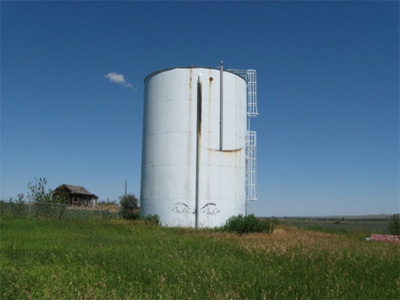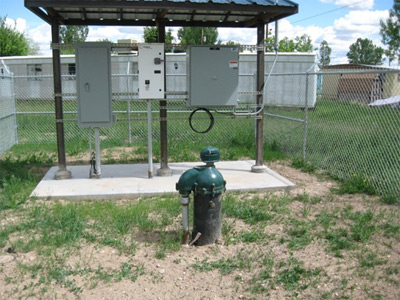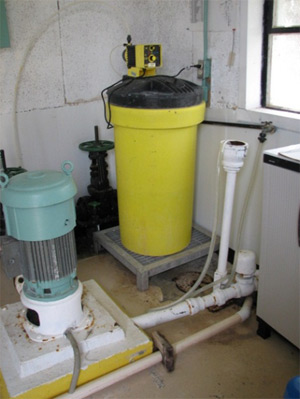- Reclamation
- Missouri Basin and Arkansas-Rio Grande-Texas Gulf
- Programs & Activities
- CMR&I – Project Need
Crow Tribe Municipal, Rural, and Industrial Water System – Project Need
Background
The water quality requirements for the proposed Crow Reservation Water System are governed by standards of the Safe Drinking Water Act (SDWA). The SDWA was originally passed by Congress in 1974 to protect public health by regulating the nation's public drinking water supply. The law was amended in 1986 and 1996, and requires many actions to protect drinking water sources such as rivers, lakes, reservoirs, springs, and groundwater wells. It is administered by the Environmental Protection Agency (EPA).
Currently, the Reservation communities of Crow Agency, Lodge Grass, Wyola, Fort Smith, Saint Xavier, and Pryor all operate under their own water treatment systems. The majority of these systems pump groundwater from wells, inject sodium hypochlorite as a disinfectant, and then store the water for use by the community. Crow Agency is the only location to utilize surface water and operate full-scale conventional water treatment plants. Rural users on the reservation often have individual wells that are privately operated and maintained.
The 2010 population of the reservation was 6,863, an increase of 55.6% since 1970 (2010 Census). The projected population for 2060 is 9,050 persons. Many water systems in this area struggle with meeting water demands and EPA SDWA standards. Even though some of the older systems have been upgraded and modified, there are many aging components, storage tanks, pipes, and treatment systems in need of replacement, maintenance, and upgrades.
Project Need
A high quality, reliable water system is needed on the Reservation because there are multiple deficiencies with the existing water systems serving communities. These deficiencies have been documented by the Indian Health Service's Sanitation Deficiency System, in Community Data Sheets and Sanitary Surveys completed by the EPA and Montana Department of Environmental Quality (MTDEQ), and in a Needs Assessment report prepared by DOWL-HKM Engineering (1999). See Appendix A of the MR&I EA for a list of the deficiencies. These reviews identified several key needs for the proposed project:
- Impaired water quality. Several existing systems throughout the Reservation have difficulties meeting primary and secondary Safe Drinking Water Standards.
- Inadequate capacity. Existing water supply systems are inefficient and present persistent maintenance challenges that affect the capacity of the system. Peak use demands may lead to a compromise between water quantity and quality. Current water supply and storage facilities were not designed or intended to support the current or future population of their respective communities.
- Poor condition of facilities. Lack of water level meters, deteriorating distribution pipes and storage tanks, and limited maintenance has created deficiencies and inefficiencies, such as overfilling, leaks, and inadequate water treatment.
- Groundwater limitations. Local water sources used for community systems are poor in quality and deficient in quantity; typical shallow wells tend to produce hard, mineralized water.
- Low water pressure. Some of the local water systems lack sufficient pressure (less than 20 pounds per square inch) and are unreliable during periods of peak use. Water shortages have been experienced when systems have failed to keep up during peak demands.
- Inadequate emergency storage. Fire protection is less than adequate for Pryor, Crow Agency, Lodge Grass, and Wyola. Fire flows (1,000 gallons per minute (gpm) for two hours) are needed to meet industry standards. Some systems do not have enough storage capacity to provide for emergency backup.
- Underserved rural areas. There are large areas of the Reservation that do not have a reliable source of water due to the low quality or quantity of groundwater. Currently, water is routinely hauled into these areas.
Benefits and Opportunities
A new MR&I water supply system would provide a number of positive benefits and opportunities to the Tribe and residents living on the Reservation.
- A new MR&I system would provide capacity for the existing population and future growth.
- The Tribe would use its water rights from the Bighorn River for beneficial purposes.
- Potential for reduction of operational and maintenance complexities and inefficiencies.
- Improvement of human health and well-being is an important benefit of clean water.
- A safe and reliable water system in turn provides opportunities for improved economic conditions and sustained viability for local communities.
- Underserved areas of the Reservation could be served and potentially developed for future uses.
- Equal opportunities for community development would be enhanced. The proposed project would fulfill a need to address disadvantages for communities with poor water systems.
- Fire control would be improved through a sufficient supply of water and on-site storage.
- The MR&I system could be designed with "Ten State Standards" and redundancy measures to improve serviceability in rural areas.
Existing Infrastructure
Crow Agency Facilities
Crow Agency operates two water treatment facilities. The first water treatment plant was constructed in Crow Agency in 1968 and the second one was built ten years later (1978) and was modified in 1995 and 2004. The Bureau of Indian Affairs (BIA) maintains one plant and the Tribe maintains the other. The BIA’s plant has a maximum daily output of 432,000 gallons per day (gpd). Its treatment process includes coagulation, clarification, filtration and the addition of chlorine gas for disinfection. The Tribal treatment plant is designed to produce 230,000 gpd. Its treatment process is similar to the BIA plant. The water produced from these plants is stored in two above ground storage tanks with a total combined capacity of 1,425,000 gallons. The distribution system consists of mostly PVC pipes, ranging in size from four to ten inches in diameter.
Lodge Grass System Facilities
During the summer, the community of Lodge Grass uses about 80,000 gallons of water per day. The water is supplied from two wells: City Hall Well, constructed in the early 1970s, and Park Well, developed in the early 1980s. The water is treated with liquid sodium hypochlorite and stored in a 200,000 gallon above-ground steel standpipe. The standpipe is regularly overfilled since there is not a water level indicator. The overflow drains into a ditch. The distribution system consists mostly of PVC pipe ranging in size from four to ten inches. There have been at least two documented leaks in the system in the last ten years.

Figure 3-1: Lodge Grass Standpipe
Wyola System Facilities
The demand on the Wyola Public Water System is approximately 325,000 gallons per month, supplied by two wells. It is unknown when the older well was drilled. The second well was put in place in 1984. The water is treated with sodium hypochlorite. In 2005, a pre-sedimentation filter and ultraviolet light were added to the treatment system for consistent disinfection, as the sodium hypochlorite disinfection alone had numerous interruptions from problems with the chemical feed pump and chemical injection. Water is stored in two underground fiberglass storage tanks installed in 2004 with a combined capacity of 55,000 gallons. The distribution system consists of eight and six inch PVC pipes.
Fort Smith System Facilities
The oldest community groundwater wells on the reservation were drilled in 1961 in Fort Smith and in non-incorporated communities near the Yellowtail Dam. Three additional wells were completed in Fort Smith in 2011 and 2012, along with a new storage tank. The water from the four wells currently in use is treated with liquid sodium hypochlorite and stored in a 200,000 gallon elevated tank. The distribution system was recently replaced with new six and eight inch PVC mains.

Figure 3-2: Park Well in Fort Smith
Yellowtail Dam Upper System Facilities
This system serves about 40 residents with one well pumping 100 gallons per minute (gpm). The water is disinfected by injecting sodium hypochlorite and the treated water is stored in a 50,000 gallon buried concrete storage tank. The distribution system contains PVC, copper, and iron piping ranging in size from 1.5 inches to 8 inches in diameter.
Yellowtail Dam Government Camp Lower System Facilities
The lower Yellowtail Dam system serves administrative, residential, and school sections of the Government Camp as well as a campground using two wells. Treatment of the water is disinfection by injecting sodium hypochlorite. Storage is an above-ground steel tank with a capacity of 100,000 gallons. The distribution system consists of PVC, copper, and iron piping. The pipe diameters range from 1.5 inches to 8 inches.

Figure 3-3: Treatment in Government Camp System
Saint Xavier/Pretty Eagle School System Facilities
The Pretty Eagle School water system serves a population of 180 during the school year. Water is provided by the Primary School Well, which was drilled in 1998 and has a maximum yield of 100 gpm. Water from the well passes through a Culligan™ ion-exchange system to soften the water and then is injected with sodium hypochlorite to disinfect the water. The water is stored in a 40,000 gallon partially buried concrete storage tank.
Pryor System Facilities
The Pryor system was developed in the 1970s and 1980s. The Pryor system uses three wells to supply water. Two of the wells are in areas where flooding can occur. Sodium hypochlorite is used for disinfection. The Pryor Storage Tank is an above-ground steel tank with a capacity of 180,000 gallons. According to the EPA Sanitary Survey in 2006, the storage tank is not structurally sound and is not maintained adequately. The distribution system contains 6 and 8 inch PVC and galvanized pipe.
Rural Systems
The majority of rural areas are served by individual wells. Deeper wells (100-250 feet) tend to have better water quality than shallow wells (20-50 feet), which are commonly contaminated by septic systems or livestock. Many wells were sampled in a community research and awareness project on the reservation in 2012. A large number of wells were found to have some level of contamination such as testing positive for fecal coliform bacteria.
Project Need
There are several key needs for the Crow Municipal, Rural & Industrial (MR&I) Water System project. In a review of water systems currently serving reservation communities, DOWL HKM and the Indian Health Service documented a number of deficiencies (DOWL HKM 1999). The review found that:
- SDWA standards were not being met, posing potential health concerns for resident consumers. In some cases water quality is unknown due to lack of standardized testing.
- Local water sources used for community systems are poor in quality and deficient in quantity. Conditions vary depending on local aquifers, but the typical shallow wells tend to produce hard, mineralized, and often contaminated water.
- Existing water supply systems are inefficient and present persistent maintenance challenges. Peak use demands may lead to a compromise between water quantity and quality.
- Local water systems lack sufficient pressure (<20 pounds per square inch) and are unreliable during periods of peak use. Systems have failed to keep up during peak demands.
- Fire protection is less than adequate for Pryor, Crow Agency, and Lodge Grass. Fire flows (1,000 gpm for 2 hours) are needed to meet industry standards.
Benefits and Opportunities
A new MR&I system would provide a safe, clean, and reliable water system, resulting in a number of positive benefits and opportunities to the Crow Tribe and residents living on the reservation.
- Safe, clean, reliable supply of drinking water to the majority of the Crow Indian Reservation, with capacity for existing and future growth.
- Improvement of human health and wellbeing.
- Opportunities for improved economic conditions and sustained viability for local communities.
- Opportunity to plan and design the water system to serve as many rural residences as feasible. Currently uninhabitable areas of the Reservation could be served and potentially developed for future uses.
- One water supply system would reduce the complexities and difficulties of troubleshooting local water systems that are prone to operational problems.
- The Tribe would beneficially use its water rights from the Bighorn River.
- Equal opportunities for community development would be enhanced. The project would fulfill a need to address disadvantages for communities with poor water systems.
- Fire flows to Pryor, Crow Agency, and Lodge Grass would be provided through on-site storage. Fire control would be improved through a sufficient supply of water.
- The system could be designed to meet or exceed industry standards and redundancy measures to improve serviceability in rural areas.
- Opportunity to provide water connections for livestock.
- The system would create operator and maintenance employment opportunities for Crow people across the entire Reservation.

